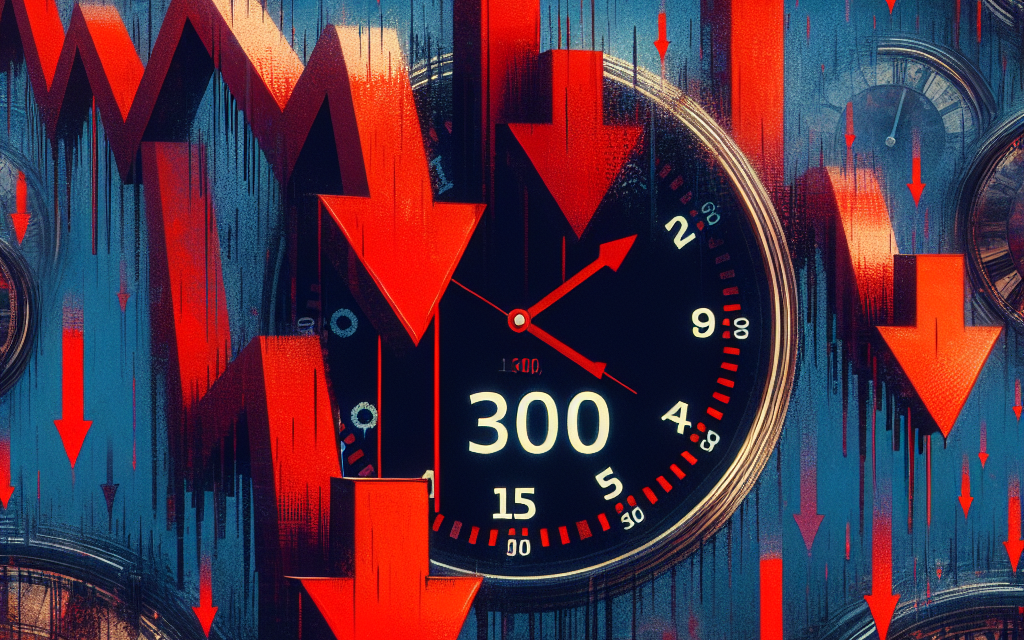“Market Turmoil: Dow Drops 300 Points in Afternoon Slide.”
Introduction
The Dow Jones Industrial Average experienced a significant decline in the afternoon session, dropping 300 points as investors reacted to a combination of economic data and corporate earnings reports. This downturn reflects growing concerns over inflation, interest rate hikes, and geopolitical tensions, prompting traders to reassess their positions in a volatile market. The sell-off highlights the ongoing uncertainty in the financial landscape, as market participants weigh the implications of recent developments on future economic growth.
Market Reaction to Dow’s 300-Point Drop
In the afternoon session of trading, the Dow Jones Industrial Average experienced a significant decline, dropping 300 points, which sent ripples through the financial markets and raised concerns among investors. This downturn can be attributed to a confluence of factors that have been affecting market sentiment in recent weeks. As the trading day progressed, the decline became more pronounced, reflecting a broader apprehension regarding economic indicators and corporate earnings.
One of the primary catalysts for the Dow’s drop was the release of disappointing economic data. Reports indicating a slowdown in manufacturing activity and weaker-than-expected job growth have contributed to a growing sense of uncertainty among market participants. Investors are increasingly wary of the potential implications of these economic signals, particularly in light of ongoing inflationary pressures and the Federal Reserve’s monetary policy stance. As the central bank continues to navigate the delicate balance between curbing inflation and supporting economic growth, any signs of economic weakness can lead to heightened volatility in the stock market.
Moreover, corporate earnings reports have also played a pivotal role in shaping market reactions. Several major companies have reported earnings that fell short of analysts’ expectations, raising concerns about the overall health of corporate America. This trend has led to a reassessment of valuations, particularly in sectors that have been previously buoyed by strong performance. As investors digest these earnings results, the Dow’s decline reflects a broader reevaluation of risk and a shift in sentiment towards more cautious investment strategies.
In addition to these economic and corporate factors, geopolitical tensions have further complicated the market landscape. Ongoing conflicts and trade disputes have created an environment of uncertainty that can lead to increased volatility. Investors are acutely aware that geopolitical events can have far-reaching implications for global markets, and as such, any escalation in tensions can trigger swift reactions in stock prices. The Dow’s 300-point drop serves as a reminder of how interconnected the global economy is and how external factors can influence domestic markets.
As the afternoon session unfolded, market analysts noted that the decline in the Dow was not an isolated event but rather part of a broader trend affecting major indices. The S&P 500 and Nasdaq also experienced declines, indicating that investor sentiment was broadly negative across the board. This collective downturn underscores the importance of monitoring market trends and economic indicators, as they can provide valuable insights into potential future movements.
In conclusion, the Dow’s 300-point drop in the afternoon session is emblematic of the complex interplay between economic data, corporate earnings, and geopolitical factors. As investors grapple with these challenges, the market’s reaction serves as a barometer of sentiment and a reminder of the inherent risks associated with investing. Moving forward, it will be crucial for market participants to remain vigilant and informed, as the landscape continues to evolve in response to both domestic and global developments. The ability to adapt to changing conditions will be essential for navigating the uncertainties that lie ahead in the financial markets.
Factors Contributing to Afternoon Market Decline
In the afternoon session of trading, the Dow Jones Industrial Average experienced a significant decline, dropping 300 points and reflecting a broader trend of uncertainty in the financial markets. Several factors contributed to this downturn, each interplaying with the others to create a challenging environment for investors. Understanding these elements is crucial for grasping the current market dynamics.
One of the primary contributors to the afternoon decline was the release of disappointing economic data. Reports indicated a slowdown in manufacturing activity, which raised concerns about the overall health of the economy. As investors digested this information, many began to reassess their positions, leading to increased selling pressure. This reaction was not isolated; it mirrored a broader sentiment among market participants who were already wary of potential economic headwinds.
In addition to the economic data, geopolitical tensions played a significant role in the market’s decline. Heightened concerns regarding international relations, particularly involving major economies, created an atmosphere of uncertainty. Investors often react negatively to geopolitical instability, as it can disrupt trade and economic growth. Consequently, as news of escalating tensions circulated, market participants became increasingly risk-averse, further contributing to the afternoon’s sell-off.
Moreover, the Federal Reserve’s recent statements regarding interest rates added another layer of complexity to the market’s performance. The central bank’s commitment to combating inflation through potential rate hikes has left many investors on edge. While some analysts argue that higher interest rates are necessary to stabilize prices, others fear that aggressive monetary policy could stifle economic growth. This dichotomy of opinion has led to volatility in the markets, as investors grapple with the implications of the Fed’s actions on future economic conditions.
Furthermore, corporate earnings reports released during the week also influenced market sentiment. While some companies exceeded expectations, others fell short, leading to a mixed bag of results. This inconsistency can create uncertainty among investors, prompting them to reevaluate their portfolios. As a result, stocks that reported weaker-than-expected earnings faced significant sell-offs, contributing to the overall decline in the Dow.
Additionally, technical factors in the market cannot be overlooked. As the Dow approached key support levels, many traders began to take profits from previous gains, exacerbating the downward momentum. This technical selling often occurs in response to psychological thresholds, where traders react to price movements rather than underlying fundamentals. Consequently, the combination of profit-taking and negative sentiment created a perfect storm for the afternoon decline.
Lastly, the overall market environment has been characterized by a sense of caution. With inflation concerns lingering and the potential for economic slowdown on the horizon, many investors are adopting a more defensive posture. This shift in sentiment can lead to increased volatility, as market participants react to news and data with heightened sensitivity. As the afternoon session progressed, this cautious approach became evident, culminating in the Dow’s significant drop.
In conclusion, the 300-point decline in the Dow during the afternoon session can be attributed to a confluence of factors, including disappointing economic data, geopolitical tensions, Federal Reserve policies, mixed corporate earnings, technical selling, and an overall cautious market environment. Each of these elements interacted to create a challenging landscape for investors, underscoring the complexities of navigating the financial markets in times of uncertainty.
Historical Context of Dow Drops: What It Means
The recent decline of 300 points in the Dow Jones Industrial Average during the afternoon session serves as a reminder of the market’s inherent volatility and the historical context surrounding such fluctuations. Understanding the implications of these drops requires a look back at the patterns and events that have shaped the stock market over the years. Historically, significant declines in the Dow have often been linked to broader economic concerns, geopolitical tensions, or shifts in investor sentiment. For instance, the market experienced dramatic drops during the financial crisis of 2008, when fears of a collapsing banking system led to widespread panic and a loss of confidence among investors. Such events underscore the interconnectedness of economic indicators and market performance, illustrating how external factors can precipitate sharp declines.
Moreover, the Dow’s performance is often viewed as a barometer of the overall health of the economy. When the index experiences a notable drop, it can signal underlying issues that may not be immediately apparent. For example, a decline may reflect concerns about inflation, interest rates, or corporate earnings, all of which can influence investor behavior. In this context, the recent drop can be interpreted as a reaction to various economic signals, including inflationary pressures or changes in monetary policy. As investors digest these signals, their reactions can lead to increased volatility, resulting in sharp movements in the index.
In addition to economic factors, historical events have also played a significant role in shaping market behavior. The dot-com bubble of the late 1990s and early 2000s serves as a pertinent example, where exuberance over technology stocks led to unsustainable valuations. When the bubble burst, the Dow, along with other indices, experienced significant declines, highlighting how speculative behavior can lead to market corrections. Similarly, the COVID-19 pandemic triggered unprecedented market volatility, with the Dow plummeting in March 2020 as uncertainty loomed over the global economy. These historical precedents illustrate that while drops in the Dow may seem alarming, they are often part of a larger cycle of market behavior influenced by a myriad of factors.
Furthermore, it is essential to recognize that while a 300-point drop may appear substantial, it is relative to the overall scale of the index. The Dow has experienced larger percentage declines in the past, and such movements can be viewed through the lens of long-term trends. Investors often adopt a perspective that emphasizes the importance of maintaining a diversified portfolio and focusing on long-term growth rather than reacting impulsively to short-term fluctuations. This approach can mitigate the emotional impact of market drops and encourage a more measured response to economic changes.
In conclusion, the recent 300-point drop in the Dow serves as a reminder of the historical context of market fluctuations and their implications for investors. By examining past events and understanding the factors that contribute to such declines, one can gain valuable insights into the nature of market behavior. While these drops can evoke concern, they also present opportunities for reflection and strategic planning. Ultimately, recognizing the cyclical nature of the market and the importance of a long-term perspective can help investors navigate the complexities of the financial landscape with greater confidence.
Investor Sentiment Following the Dow’s Afternoon Slide
On a day marked by volatility, the Dow Jones Industrial Average experienced a significant drop of 300 points during the afternoon session, prompting a wave of concern among investors. This decline, which unfolded against a backdrop of mixed economic indicators and geopolitical tensions, has led to a palpable shift in investor sentiment. As market participants digested the implications of this downturn, a variety of factors came into play, influencing their outlook and decision-making processes.
Initially, the afternoon slide can be attributed to a combination of disappointing earnings reports from key companies and ongoing inflationary pressures that have continued to plague the economy. Investors had been cautiously optimistic in the lead-up to this session, buoyed by previous gains and a sense of resilience in the market. However, as earnings reports began to trickle in, it became evident that several major corporations were struggling to meet expectations, raising concerns about the overall health of the economy. This realization prompted a reevaluation of stock valuations, leading to a sell-off that contributed to the Dow’s sharp decline.
Moreover, the specter of rising interest rates loomed large over the market, further exacerbating investor anxiety. The Federal Reserve’s commitment to combating inflation through monetary tightening has created an environment of uncertainty, as market participants grapple with the potential for increased borrowing costs and their subsequent impact on consumer spending and corporate profits. As the afternoon progressed, the realization that higher rates could stifle economic growth began to weigh heavily on investor sentiment, prompting many to reassess their positions and adopt a more cautious approach.
In addition to domestic economic concerns, geopolitical factors also played a significant role in shaping investor sentiment during this tumultuous session. Heightened tensions in various regions, particularly those involving trade relations and military conflicts, have contributed to a sense of unease among investors. The interconnectedness of global markets means that developments abroad can have immediate repercussions on domestic equities. As news of escalating tensions broke, many investors opted to retreat to safer assets, further fueling the Dow’s decline.
As the afternoon session wore on, the mood among investors shifted from cautious optimism to a more defensive posture. Many began to seek refuge in traditionally safer investments, such as bonds and gold, as they braced for potential further declines in the equity markets. This flight to safety is indicative of a broader trend that often emerges during periods of heightened uncertainty, as investors prioritize capital preservation over aggressive growth strategies.
In conclusion, the Dow’s 300-point drop in the afternoon session serves as a stark reminder of the fragility of investor sentiment in the face of economic and geopolitical challenges. The interplay of disappointing earnings, rising interest rates, and global tensions has created an environment where caution prevails. As investors navigate this complex landscape, it is essential for them to remain vigilant and adaptable, recognizing that market conditions can shift rapidly. Ultimately, the ability to respond to these changes will be crucial in determining their investment strategies moving forward.
Sector Performance During the Dow’s 300-Point Drop
On a day marked by significant volatility, the Dow Jones Industrial Average experienced a notable decline, dropping 300 points during the afternoon session. This downturn was not merely a reflection of the index’s performance but also indicative of broader sector trends that contributed to the overall market sentiment. As investors grappled with various economic indicators and geopolitical tensions, certain sectors emerged as particularly vulnerable, while others displayed resilience amidst the turbulence.
The technology sector, often seen as a bellwether for market performance, faced considerable pressure during this period. Major tech stocks, which had previously driven much of the market’s gains, saw sharp declines as investors reassessed their valuations in light of rising interest rates and inflationary concerns. Companies that had thrived during the pandemic, such as those in e-commerce and cloud computing, experienced sell-offs as market participants shifted their focus toward more traditional sectors that might benefit from a reopening economy. This shift not only impacted the tech sector but also contributed to the overall downward momentum of the Dow.
In contrast, the energy sector exhibited a degree of strength during the Dow’s decline. As oil prices remained elevated due to ongoing supply chain disruptions and geopolitical tensions, energy stocks benefitted from heightened demand and favorable pricing. This divergence in performance highlighted the complexities of the current economic landscape, where certain sectors could thrive even as the broader market struggled. Investors seeking refuge from the volatility often turned to energy stocks, which provided a counterbalance to the losses seen in technology and other growth-oriented sectors.
Moreover, the financial sector also played a crucial role in the afternoon’s market dynamics. Banks and financial institutions, which typically benefit from rising interest rates, experienced mixed results. While some institutions reported strong earnings driven by increased lending activity, others faced headwinds from concerns about potential loan defaults and economic slowdowns. This uncertainty within the financial sector contributed to the overall market’s volatility, as investors weighed the implications of a potentially tightening monetary policy against the backdrop of an uncertain economic recovery.
Consumer discretionary stocks, which are sensitive to changes in consumer spending, also felt the impact of the Dow’s decline. As inflationary pressures continued to mount, concerns about consumer purchasing power led to a sell-off in this sector. Retailers and companies reliant on discretionary spending faced scrutiny as investors anticipated a potential slowdown in consumer confidence. This trend underscored the interconnectedness of various sectors, as shifts in consumer behavior could reverberate throughout the economy, influencing everything from manufacturing to services.
In summary, the Dow’s 300-point drop during the afternoon session was emblematic of a complex interplay between various sectors, each responding differently to the prevailing economic conditions. While technology stocks faced significant headwinds, energy and financial sectors displayed resilience, albeit with their own set of challenges. As investors navigate this multifaceted landscape, the performance of these sectors will continue to be closely monitored, providing insights into the broader economic trajectory. Ultimately, the market’s fluctuations serve as a reminder of the intricate relationships that define sector performance and the ongoing uncertainties that shape investor sentiment.
Strategies for Investors Amid Market Volatility
In the wake of the Dow dropping 300 points during the afternoon session, investors are faced with the challenge of navigating a turbulent market landscape. Such fluctuations are not uncommon, particularly in an economic environment characterized by uncertainty and rapid changes. As market volatility becomes a recurring theme, it is essential for investors to adopt strategies that can help mitigate risks while capitalizing on potential opportunities.
One of the first strategies to consider is diversification. By spreading investments across various asset classes, sectors, and geographic regions, investors can reduce the impact of a downturn in any single area. This approach not only helps to cushion against losses but also positions investors to benefit from growth in other sectors that may perform well during turbulent times. For instance, while technology stocks may be experiencing a decline, sectors such as healthcare or consumer staples might be thriving, providing a buffer against overall market volatility.
In addition to diversification, maintaining a long-term perspective is crucial. Market fluctuations can often lead to emotional decision-making, prompting investors to react impulsively to short-term movements. However, history has shown that markets tend to recover over time. By focusing on long-term goals and remaining committed to a well-thought-out investment strategy, investors can avoid the pitfalls of panic selling and instead take advantage of lower prices to acquire quality assets.
Furthermore, it is advisable for investors to consider dollar-cost averaging as a method to navigate market volatility. This strategy involves consistently investing a fixed amount of money at regular intervals, regardless of market conditions. By doing so, investors can reduce the impact of market timing and potentially lower the average cost of their investments over time. This disciplined approach not only fosters a sense of routine but also encourages investors to remain engaged with their portfolios, even during periods of uncertainty.
Another important aspect to consider is the role of cash reserves. In volatile markets, having liquidity can provide investors with the flexibility to seize opportunities as they arise. For instance, when stock prices decline, investors with cash on hand can purchase undervalued assets, positioning themselves for potential gains when the market rebounds. This strategy not only allows for opportunistic buying but also serves as a safety net during periods of heightened volatility.
Moreover, staying informed about market trends and economic indicators is essential for making informed investment decisions. By keeping abreast of relevant news and analysis, investors can better understand the factors driving market movements and adjust their strategies accordingly. This proactive approach enables investors to anticipate potential risks and opportunities, allowing them to navigate the complexities of the market with greater confidence.
Lastly, seeking professional advice can be invaluable during times of market volatility. Financial advisors can provide personalized guidance tailored to an investor’s specific goals and risk tolerance. They can also help in developing a comprehensive investment strategy that accounts for both short-term fluctuations and long-term objectives. By leveraging the expertise of professionals, investors can enhance their decision-making process and better position themselves for success in an unpredictable market environment.
In conclusion, while the recent drop in the Dow serves as a reminder of the inherent risks in investing, it also highlights the importance of employing effective strategies to navigate market volatility. By diversifying portfolios, maintaining a long-term perspective, utilizing dollar-cost averaging, keeping cash reserves, staying informed, and seeking professional advice, investors can enhance their resilience and adaptability in the face of uncertainty. Ultimately, these strategies can empower investors to not only weather the storms of market fluctuations but also to thrive in the long run.
Future Outlook: What the Dow’s Decline Indicates
The recent decline of the Dow Jones Industrial Average by 300 points during the afternoon session has raised significant concerns among investors and analysts alike. This drop, while not unprecedented, serves as a critical indicator of underlying economic sentiments and market dynamics. As we delve into the implications of this decline, it becomes essential to consider the broader context in which these fluctuations occur.
Firstly, the decline in the Dow can be attributed to a confluence of factors, including rising interest rates, inflationary pressures, and geopolitical uncertainties. As the Federal Reserve continues to navigate its monetary policy in response to inflation, the prospect of higher interest rates has led to increased volatility in the stock market. Investors, wary of the potential for reduced consumer spending and corporate profits, often react swiftly to such news, resulting in sharp declines like the one witnessed recently.
Moreover, the current economic landscape is characterized by persistent inflation, which has eroded purchasing power and created uncertainty in consumer behavior. As prices for essential goods and services continue to rise, consumers may curtail their spending, leading to a slowdown in economic growth. This potential slowdown can have a cascading effect on corporate earnings, prompting investors to reassess their positions in the market. Consequently, the Dow’s decline may reflect a broader apprehension regarding the sustainability of economic recovery.
In addition to domestic factors, global events also play a pivotal role in shaping market sentiment. Geopolitical tensions, trade disputes, and supply chain disruptions can significantly impact investor confidence. For instance, ongoing conflicts or diplomatic strains can lead to fluctuations in commodity prices, which in turn affect the profitability of companies within the Dow. As such, the recent drop may signal a growing unease among investors about the stability of international markets and their potential repercussions on the U.S. economy.
Looking ahead, the future outlook for the Dow and the broader market remains uncertain. While some analysts argue that the recent decline presents a buying opportunity, others caution that the volatility may persist as economic indicators continue to fluctuate. The upcoming earnings reports from major corporations will be closely scrutinized, as they will provide insights into how companies are navigating the current economic challenges. Positive earnings surprises could bolster investor confidence, while disappointing results may exacerbate fears of a downturn.
Furthermore, the Federal Reserve’s actions in the coming months will be critical in shaping market trajectories. If the Fed signals a more aggressive stance on interest rates, it could lead to further declines in the stock market. Conversely, if the central bank adopts a more dovish approach, it may alleviate some of the pressures currently weighing on investor sentiment. Thus, the interplay between monetary policy and market performance will be a key factor to monitor.
In conclusion, the recent 300-point drop in the Dow serves as a stark reminder of the complexities inherent in the financial markets. As investors grapple with a myriad of economic indicators and global events, the future outlook remains fraught with uncertainty. While the potential for recovery exists, it is essential for market participants to remain vigilant and informed, as the landscape continues to evolve. Ultimately, understanding the factors driving these fluctuations will be crucial for navigating the challenges and opportunities that lie ahead.
Q&A
1. **Question:** What caused the Dow to drop 300 points in the afternoon session?
**Answer:** The drop was primarily due to concerns over rising interest rates and disappointing earnings reports from major companies.
2. **Question:** How did investors react to the news of the Dow’s decline?
**Answer:** Investors showed increased caution, leading to a sell-off in stocks, particularly in technology and consumer discretionary sectors.
3. **Question:** What impact did the Dow’s drop have on other major indices?
**Answer:** The S&P 500 and Nasdaq also experienced declines, reflecting broader market concerns.
4. **Question:** Were there any specific sectors that were hit hardest by the Dow’s drop?
**Answer:** Yes, the technology and financial sectors were among the hardest hit, with several key stocks experiencing significant losses.
5. **Question:** How did analysts interpret the Dow’s decline?
**Answer:** Analysts viewed the decline as a potential signal of market volatility and uncertainty regarding economic growth.
6. **Question:** What was the overall market sentiment following the Dow’s drop?
**Answer:** The overall market sentiment was cautious, with many investors seeking safer assets amid rising economic uncertainties.
7. **Question:** Did the Dow’s drop have any long-term implications for the market?
**Answer:** Yes, it raised concerns about potential corrections and the sustainability of the current market rally, prompting discussions about future economic policies.
Conclusion
The Dow’s drop of 300 points in the afternoon session reflects investor concerns over economic indicators, rising interest rates, or geopolitical tensions, signaling potential volatility in the market. This decline may prompt investors to reassess their strategies and could lead to further fluctuations in the coming days.





